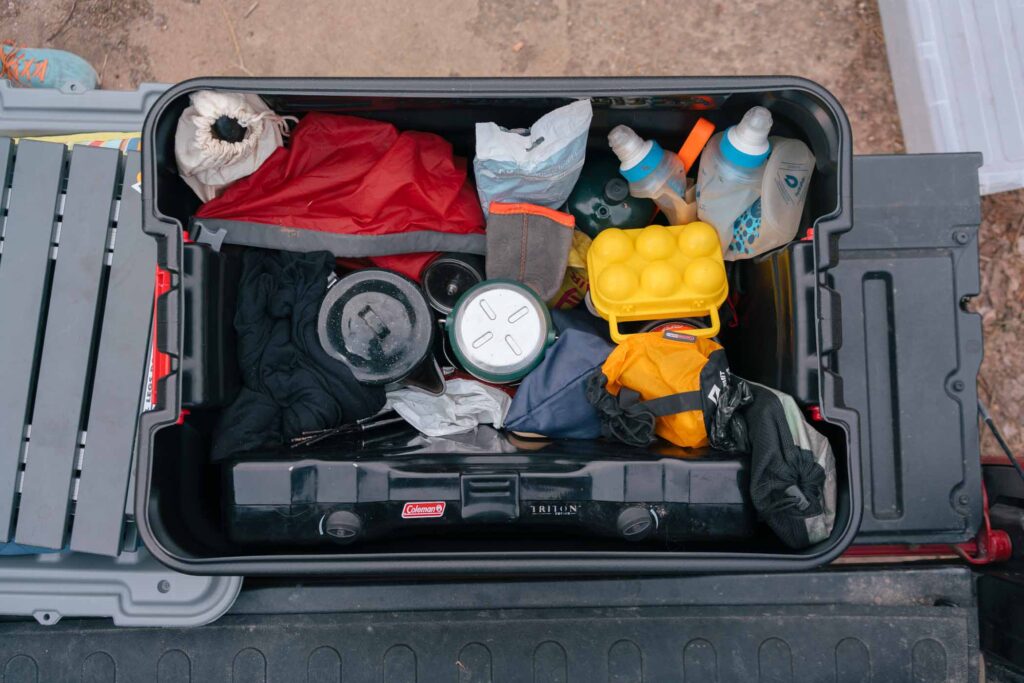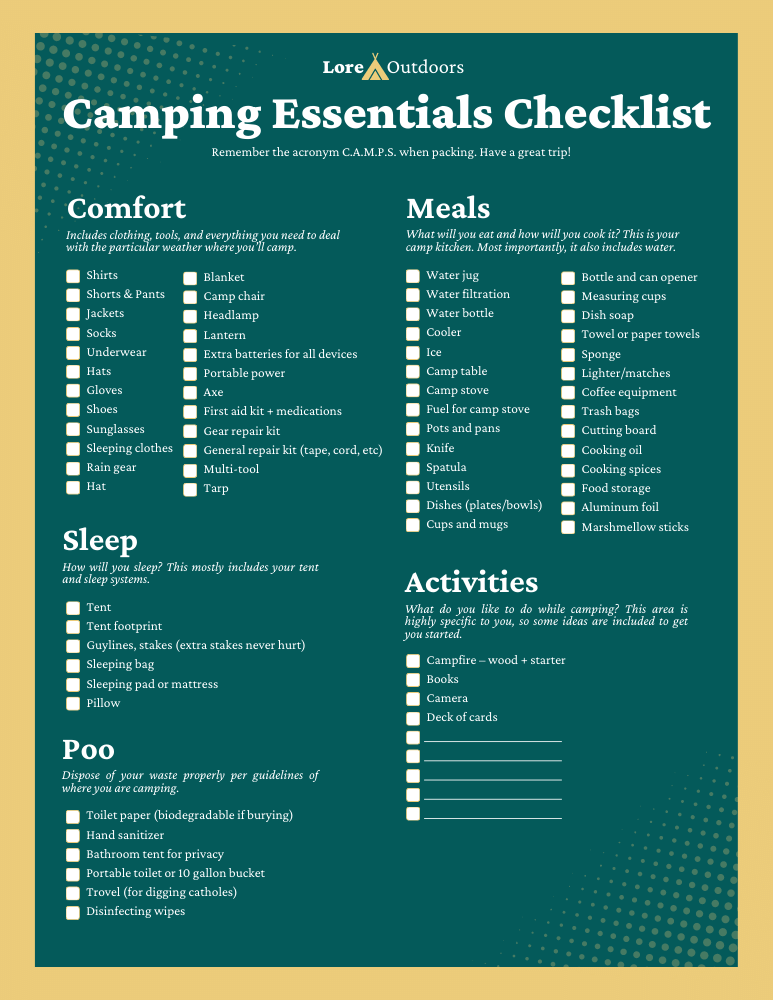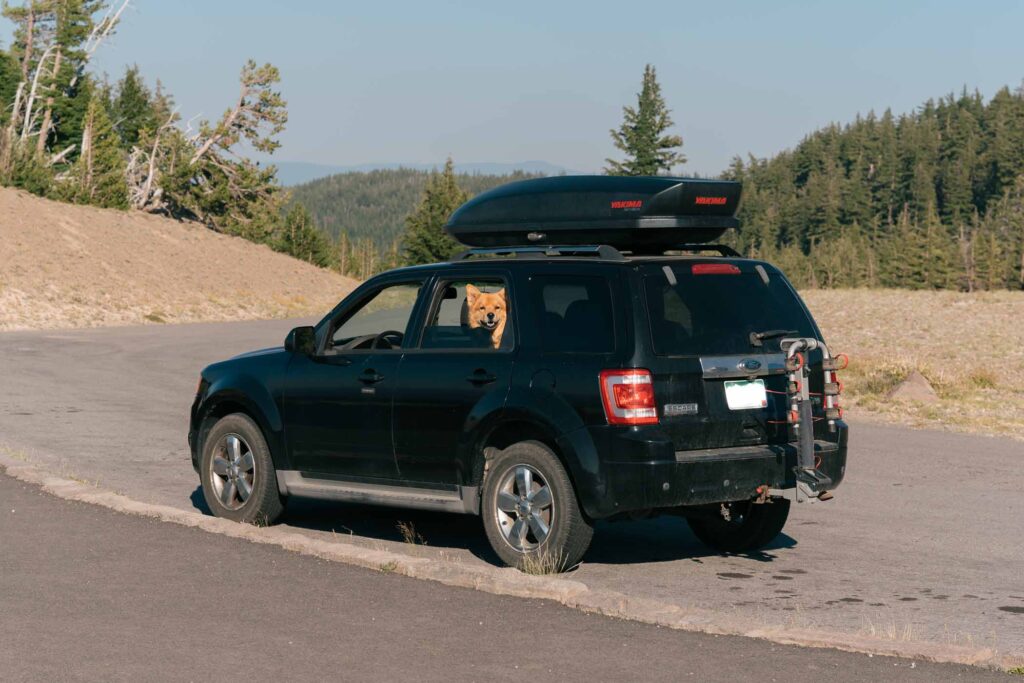When I plan a camping trip in the mountains the last thing on my mind is the time spent packing, unpacking, and setting up camp. We don’t camp for those activities. But without a great setup and organization, you’ll waste hours before, during, and after your trip doing all these things instead of enjoying yourself. Camping storage and gear organization is one of the most underrated improvements you can make to enjoy more of your time outdoors. By dialing in your setup you’ll save time, stress, and keep the focus on what matters: living in the moment.
So today I’ll walk through what I’ve learned about camping storage options and organization tips to reduce the time you spend worrying about it. Here’s what we’ll cover:
- How to store and organize your camping equipment
- The best camping storage boxes and bins
- Food storage for camping
- How to properly store and care for your camping equipment at home
- Exterior storage ideas for your car
How to store and organize your camping equipment

Most people should get one dedicated camping box for all their basic camping equipment. Simple as that. As you get more gear additional options may be helpful, and we’ll talk through those below, but one main box should be what you start with.
The camping box is one of the most underrated pieces of equipment you can buy. You don’t need to spend a fortune to get a good one, it should last you a decade or more, and it has multiple uses outside stashing gear. It’s a great example of what I like to call quiet gear, which means if it’s working well you don’t notice or think about it. I shouldn’t have to pay special attention to a storage bin, it should do what I want without hassle.
I started with a small, clear, plastic office box typically used for filing papers. All my basic camping gear went in there, my clothes went in a duffel bag I already had, dry goods and food in a re-usable grocery bag, perishables in a cooler, and any other random accessories packed in the car by themselves. I did all types of camping for years this way without issue, which goes to show you don’t need to overthink it.
Even that little box lasted me a few years before it was overflowing and breaking apart. I started battling against it every trip and that’s when I knew it needed to go. Upgrading to my recommendation, the Rubbermaid Actionpacker 24 gallon (see all my recommendations below), made multiple aspects of camping trips better.
Your camping box can be a storage bin, seat, cutting board, anchor weight, whatever you need it to be. Here’s what you should look for:
Capacity
Minimum 18 gallons. Any less and you run out of room quickly. I like 24 gallons because you can fit all the basics including your camp stove, fuel, kettle, blanket, and even a small table inside. Keeping everything in one place means less gear left behind and less time worrying about it.
One thing to keep in mind here is how much room you have in your car. I camped in a Ford Escape with 1-2 people and a large dog and never had an issue, but you’ll want to make sure everything fits easily.
Finally, think about weight. The bigger the box the heavier it will be, especially when packed full. Make sure you pack it, carry it, and use it safely.
Toughness & weatherproofing
Like I mentioned with my first camping box, you need something that can handle life outdoors—meaning scuffs, weather, or a person sitting on top.
Choose between hard-sided or soft-sided depending on your needs. I’ll always prefer hard-sided for my main camping box because I like it being able to handle all of the above. But there are some great soft-sided options that retain toughness nowadays. So if weight and packability are important, or you’ll use it for something other than camping, then soft-sided could work.
Weatherproof is a non-negotiable. Gear should be protected from rain, mud, food, and for some options even animals.
When one camping box isn’t enough
For regular car camping, the one camping box method works great. Even though I go backpacking regularly, my backpacking gear gets used for both and thus stays in the same camping box. The only dedicated pieces of backpacking gear (not including clothes, sleeping bags, etc.) that don’t fit in my camping box are the backpack itself and my bear box.
However, if you’re overlanding or spending a lot of time camping then investing in more storage solutions is worth it. More time outside means more gear, more specific storage needs, and likely a more sophisticated setup in general. When this is the case here’s how I recommend thinking about splitting up your gear:
- Core camping equipment—tents, sleeping bags, axe, first aid, repair kits, lantern, etc.
- Cooking equipment—stove, fuel, pans, utensils, coffee gear, spices, cooking oil, etc.
- Extras—games, activity-specific gear (ex. Fishing rods), campsite lights, etc.
Tips for organizing gear in your camping box

You can throw all your gear in your box and you’ll be ok, but if you really want to step up your game and make things easy on yourself then organizing things within the box is the next step. I recommend two different items to do this, depending on your needs:
Dry bags—I love dry bags. Since I backpack a lot I use them to organize and keep key items safe from the elements on those trips, but then use them more broadly for organization on regular car camping trips.
- Pros: they’re waterproof, cheap, and pack down nicely when not full of gear. One thing to keep in mind is they keep liquids in just as much as out. Dry bags give me peace of mind when storing soap, oils, or other things that can spill.
- Cons: No structure so they may lack an organizational feel when shoved in your camping box, and they generally won’t fit as much as packing cubes.
Many brands make solid dry bags, but Sea to Summit has always been trustworthy and high quality. Check out their 3-bag kit here for different needs.
Packing cubes—You might already have these for normal travel. Packing cubes are just as useful for gear as they are for clothes.
- Pros: Usually spacious, come in different shapes, and very stackable for clean organization.
- Cons: Typically not waterproof, not as multipurpose as dry bags.
REI makes a great set of regular packing cubes. Thule offers a great compressable option.
FYI: We’re a small team of outdoor experts and researchers that care about recommending quality, reliable outdoor products. If you choose to click a link and buy any of the products we recommend, we earn a commission at no additional cost to you.
The best camping storage boxes and bins
Here are my recommendations for the best camping boxes and bins.
The best camping box for most uses: Rubbermaid Actionpacker 24 gallon (single option)

The box I personally use and recommend. 24 gallons means I can fit my stove, fuel, blanket, kettle, and all miscellaneous gear including a small camp table in one place. It’s durable, offers an option to lock the box at the handles to protect from animals (I wouldn’t call this bear proof though), and is plenty sturdy to sit on. All that in an affordable package.
They also offer an 8-gallon option if you need a sidekick for it. Yeti and Dometic offer popular competitors, but with slightly less storage at 3x and 5x the price I can’t recommend them over the Actionpacker.
High quality and multifunctional: Rux 70L Gear System
Yes, $300 is a ton of money for a storage piece. However, Rux has done an incredible job designing this thing with multiple ways to carry, a weatherproof but soft-sided exterior, packability, and even components for securing to trucks and boats.
I think this is the direction high quality storage is moving as soft-sided materials get stronger. If you have multiple uses for this type of storage and can afford the price tag the Rux is a great and good-looking option.
Large, soft-sided storage: REI Pack-Away Bin
If you’re looking for a soft-sided option without the price tag of the Rux, check out REI’s pack-away line. They’re plenty big in 100L and 140L options. I’d go with the 100L for most uses. Plus, you can use their packing cubes to further organize. While they are sturdy, they aren’t weatherproof so you’ll want to watch how you use them.
Large, hard-sided options: Rubbermaid Actionpacker wheeled 35 Gallon
Unsurprisingly, I recommend the larger versions of the Actionpacker if you need durable high volume storage. Their 35 gallon comes with a wheeled option, which is great considering their 24 gallon already gets heavy when loaded up. If you pack enough gear to survive for weeks they even offer a 48 gallon (unwheeled) option, but I think its better suited for storage at home.
If you’re looking at large hard-sided camping storage, portability becomes a major issue if you’re going to load it up with gear other than clothes. Keep this in mind when looking at sizes over 24 gallons.

Use our printer-friendly checklist as a shopping list or packing list for your next camping trip.
Food storage for camping
There are simple solutions for keeping food fresh for multiple days. For perishables you need to bring along a cooler. For dry goods you can use anything from a grocery bag to a milk crate. Coolers are a whole separate rabbit hole we can go down, but here are a few options I like:
Yeti Tundra 45L Cooler
Yeti is the king of camping coolers for a reason. Are they expensive? Yes. Are they basically indestructible? Yes. Do they keep everything cold for days on end? Yes. I wouldn’t get under a 45L in highly insulated coolers like Yeti’s because you’ll run out of space quickly. But the 45L is great for most weekend car camping trips to fit drinks and food.
RovR RollR 45L Wheeled Cooler
This local (to me) company burst on the scene with a wheeled cooler option that offers all the insulation capability Yeti does. Since these coolers get heavy fast, the RollR’s off-road capable tires are a great option for outdoor use.
Igloo 52qt Cooler
There are a slew of affordable options on the market from brands like Igloo, Coleman, and others. I started with a smaller, wheeled Igloo. They work and will do just fine, but you’ll be dealing with a lot of melted water so know that when planning how you pack your food inside it. You’ll want to make sure all your food is watersealed if you’re planning on using this for a few days, and draining out water will become a regular habit.
Again, they work great for what they are. They are affordable, lighter, and still plenty sturdy. But the insulation on better options can’t be matched. It just matters how important this is to your experience.
Dry good storage options
I personally like using reusable grocery bags. They’re tough, offer a lot of volume, and are cheap. But there are plenty of ways to pack dry goods for your trip, so here are a couple other options:
- Insulated bag—A bit more structure than regular grocery bags with some insulation to boot.
- Collapsible Milk Crates—Easy, packable, stackable. Here’s a slightly bigger option or non-collapsible.
How to properly store and care for your camping equipment at home
Don’t just toss everything in a closet when you get home. Spending the extra time caring for and storing your equipment is worth it for when you’re packing up the next time. It’ll save you time, help your gear last longer, and prevent mold and mildew. Follow these guidelines when you’re unpacking at home:
- All items that were used or got dirty should be washed in the appropriate way. This includes all kitchen items, your tent, sleeping bag, clothes, This usually means what I call a gear explosion in my house after every trip. Everything gets taken out and cleaned before being stored away.
- Everything must be dry before you store it away. This is how mold and other gross bacteria comes around.
- All pans, utensils, and my camp stove get washed and dried. There’s a good chance you’ve got oil splatter on your stove and other items. My cooler gets emptied, opened, and set upside down outside to dry.
- Make sure all tents, sleeping bags, tarps, and similar items are hung up to dry in the sun. Even if it doesn’t rain morning dew and condensation occurs. I lay everything out in the sun, ideally hung up. If you can’t hang it outside hang it inside somewhere dry so it can air out. I flip my sleeping bag inside out to make sure it can breathe. Any major dirt spots are given a quick clean as well.
- Make sure any liquids such as soap, cooking oil, and bug spray are sealed correctly to prevent leaking.
- Fuel should also be stored upright and you should make sure the temperature is safe where you’re keeping fuel, oil, and other items more reactive to temperature. Garages are common, if I don’t have a garage I keep it in a separate closet.
Make this your ritual when you get home from a camping trip, your gear and future self will thank you. Next time you’re packing up you can grab your gear and go knowing it’ll be ready for use when you get to your campsite.
Exterior storage ideas for your car

Sometimes you run out of room in your car, whether its because of kids, furry friends, or that Traeger grill you just have to bring. Not to worry, there are still ways to make this work. Believe it or not I spent over a year traveling out of my Ford Escape with my pup in tow. I was able to do this mainly thanks to exterior storage. Roof boxes and hitch carriers are examples of typical products used to expand your capacity. Let’s walk through a couple different ways you can store items outside your vehicle.
Always make sure your vehicle is compatible with gear. Certain size roof boxes won’t fit every car, hitch carriers require certain hitch receivers, roof racks are often required for attaching anything on top your car. Research beforehand so you don’t buy something you can’t use. For me, ski storage was key so I made sure the box could fit my length skis.
- Yakima roof boxes—I used their Skybox Carbonite (3 options available – 12, 16, 21 cubic feet) in my travels and loved it. Sturdy, weatherproof, easy to install, aerodynamic (the hit on mpg wasn’t bad at all), and can hold more than you think. They are expensive, but they work really well. Head to Yakima’s website and enter your vehicle information to make sure it’ll fit.
- Hitch carriers—These go into your car’s tow hitch receiver, offering a platform to put boxes and other items. They are flexible and offer a lot of storage, just make sure to properly secure everything. This option comes with accessories and even a cover for your items to help with these issues. Make sure you have the right tow hitch on your car to fit the product before you buy. Yakima offers the EXO Swingbase you can customize with a gearbox and other options, but it’s pricey.
- Cargo carriers, cargo baskets, and roof bags—I’m grouping these together because they’re less aerodynamic than the options above but still widely used and more affordable. They also offer some flexibility with what gets packed in them versus the aerodynamic carriers like the Skybox above. If you don’t want to drop the cash on a high-end roof box or your gear needs a boxier fit, these are great solutions. Remember to make sure you have the proper vehicle or roof rack installed to support it.
Camping storage: Burden or routine?
This is not the glamorous side of camping. No one wants to spend a lot of time thinking about plastic boxes and packing up the car. But I’ll always contend this part of camping can be an easy routine or a painful burden. It’s up to you to find the right solution for your style of camping, the number of people you have, and what vehicle you drive.
I hope this guide helped you find the right solution for you. If you use any of the gear I recommend here and have feedback please let me know at [email protected]. I always want to make sure the products I recommend are holding up and hearing your experiences helps me do that.
Alex Eaton
I'm Alex, the founder of Lore. My life outside started with camping trips in southern Indiana as a kid, and has taken me across the world. My goal is to give you the tools and confidence you need to pursue the outdoor life you want.
Use our printer-friendly checklist as a shopping list or packing list for your next camping trip.